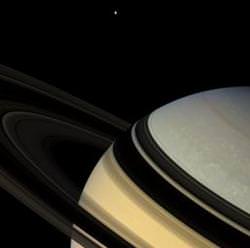[caption id="" align="alignnone" width="500" caption="Rhea, Saturn's rings and some sister moons. Credit: NASA/JPL/Space Science Institute"]
[/caption]
Jia-Rui C. Cook from the Cassini team
sent out an alert
that raw images from Cassini's closest flyby of Saturn's moon Rhea have begun streaming to Cassini's raw image page, and they are well worth a look. At closest approach, Cassini came within about 69 kilometers (43 miles) of Rhea's surface on Jan. 11. But there's also some interesting group photos from within the Saturn System. One of the best is this image, above. How many moons can you find? I probably wouldn't have seen them all but
Emily Lakdawalla at the Planetary Blog
spied five moons and the rings in this one wide-angle shot. The large moon is Rhea; above Rhea and just below the rings, is Dione; above and to the left of Rhea is Tethys. Then there are two tiny moons: squint hard to see Prometheus as tiny lump on the rings to the left of Dione, and Epimetheus is hovering between Tethys and Rhea. See some more, including closeups of Rhea and Saturn's storm, below.
[caption id="" align="alignnone" width="500" caption="Rhea dwarfs Dione, which appears to be stuck on Saturn's rings. Credit: NASA/JPL/Space Science Institute"]
[/caption]
[caption id="" align="alignnone" width="500" caption="X marks the spot on Rhea. NASA/JPL/Space Science Institute"]
[/caption]
[caption id="" align="alignnone" width="500" caption="Closeup of Rhea's craters. Credit: NASA/JPL/Space Science Institute"]
[/caption]
[caption id="" align="alignnone" width="500" caption="The storm on Saturn is spreading, as seen in this latest image taken on January 12, 2011 by Cassini. Credit: NASA/JPL/Space Science Institute"]
[/caption]
See more at Cassini's raw image page.
 Universe Today
Universe Today
